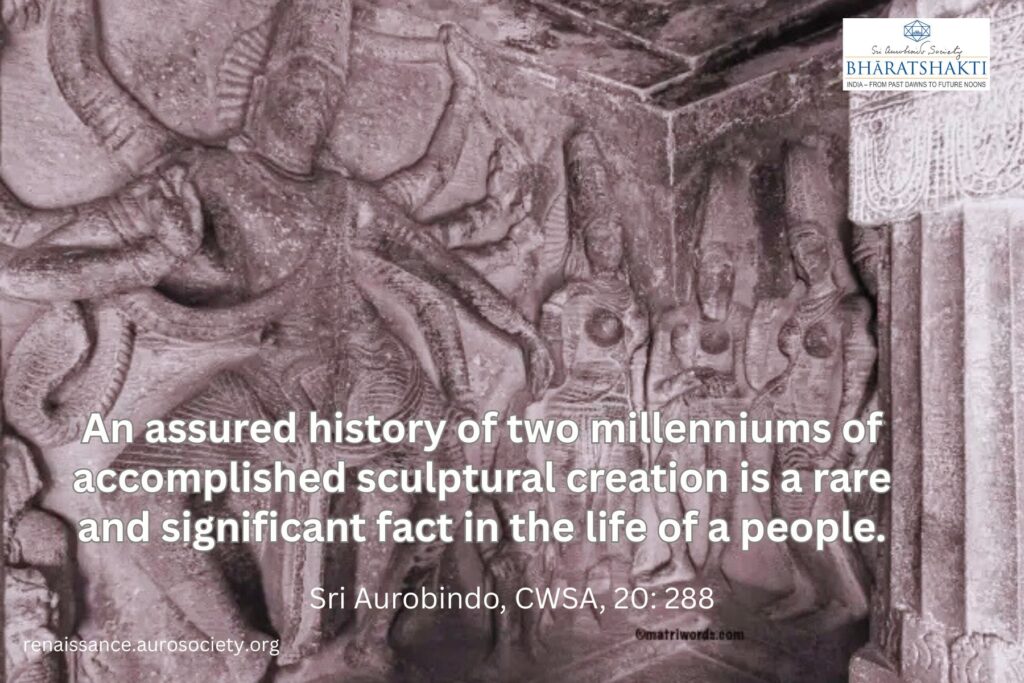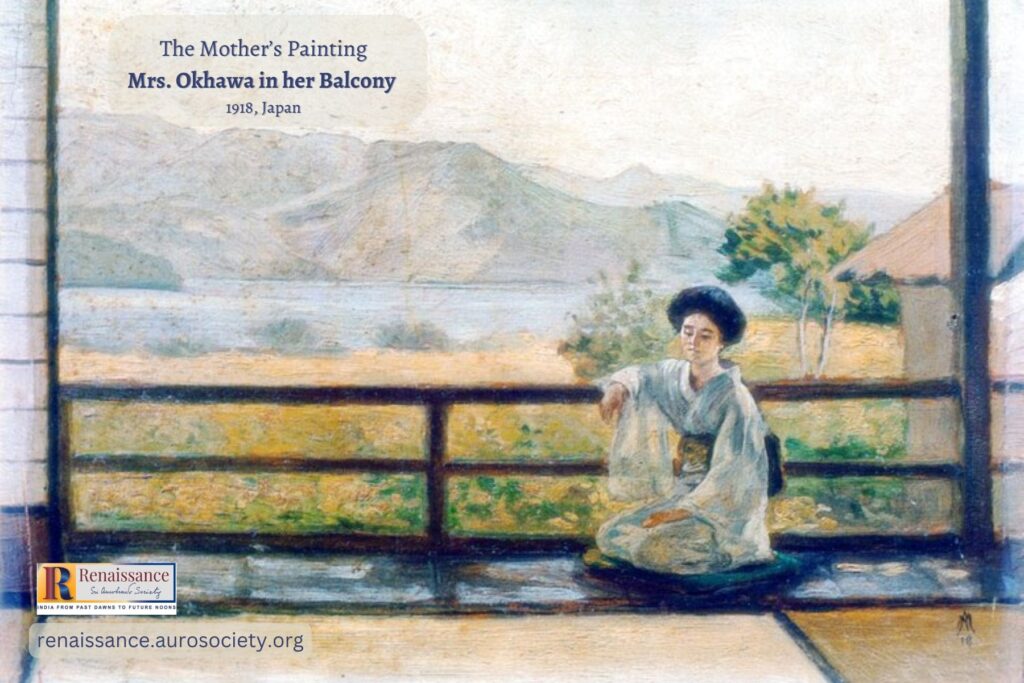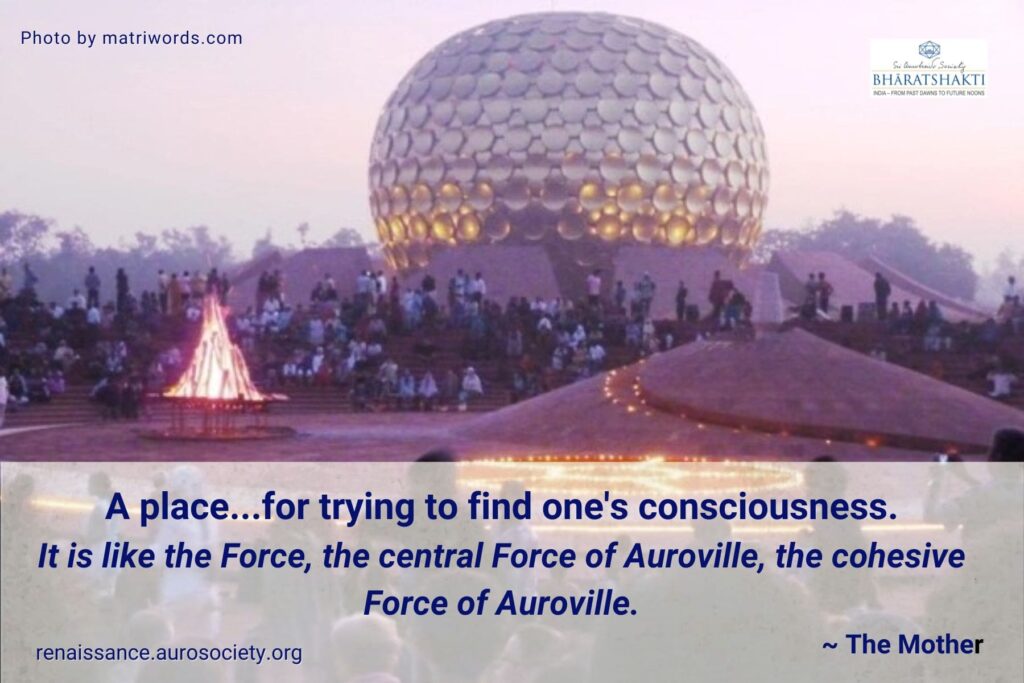Editor’s Note: Nolini Kanta Gupta describes in these passages how Sri Aurobindo established the Ashram, the golden temple of the Mother Divine, in Pondicherry, amidst the pathetic deadness of then Pondicherry and the conspiracy and serious attacks from the British government. He also brings out the connection of Sri Aurobindo’s yogic aim with the yoga of Vedic Rishis.
Readers can find the full essay titled ‘Pondicherry – 1’ in Collected Works of Nolini Kanta Gupta, Vol. 7, pp. 400-408. We have made a few minor formatting revisions for this digital presentation.
🌸🌸🌸
Then Pondicherry, a city of the dead
Sri Aurobindo came to Pondicherry in 1910*. The place was so quiet that we can hardly imagine now what it was really like. It was not quiet, it was actually dead. They used to call it a dead city. There was hardly any traffic, particularly in the area where we lived. And after dusk there was not a soul stirring. It is no wonder they should say, “Sri Aurobindo has fixed upon a cemetery for his sadhana.”
It was a cemetery indeed. Whilst the Indian nationalist movement had been flooding the whole country, nothing of that regenerating flood could find an entry here, except for one or two individuals who had felt a touch. It was like a backwater of the sea, a stagnant pool by the shore. There was here no such thing as a public life or a youth movement or any kind of collective effort or an experiment in educational reform. There was no sign whatsoever of an awakening to life.
A cemetery it was no doubt, but one with its full complement of ghosts and ghouls.
In the first rank of these ghouls were the ruffian bands. Such creatures can appear only in a highly tamasic environment. For, the greater the depth of inertia the more is the need for keen rajasic excitement followed immediately by the silence of sleep. Pondicherry of those days had a still more notorious reputation for its cheap wine shops and its rowdy tipsies. Of this type of ghouls there was a regular invasions from outside every week-end.
[…]
Soon after Sri Aurobindo came, he realised that a firm seat must be established here, an unshakable foundation for his sadhana and siddhi, for the path and the goal. He was to build up on the ever-shifting sands of the shore a firm and strong edifice, a Temple of God.
Have we not read in the Puranas and other scriptures that whenever and wherever a sage or a Rishi sat down to his meditation and sadhana, there rushed upon him at once a host of evil spirits to break up his work? They seemed to have a special liking for Rishi’s flesh.
Those who tried most to stop Sri Aurobindo from settling down and were ever on the alert to move him from his seat were the British authorities. The British Government in India could never accept that Sri Aurobindo had come away to French territory for carrying on his yoga. Religion and spirituality, these to them were a mere subterfuge.
They thought they knew what Sri Aurobindo was – the most dangerous man in all India, the source of all the trouble.
Pondicherry was the place from where were supplied the necessary instructions and advice and perhaps even the pistols and other weapons. Here was the brain-centre of the Indian independence movement. That Sri Aurobindo had been the mainspring of Indian independence they had been told by their life-instinct, although the superficial sense in which they understood it was not obviously the whole truth.
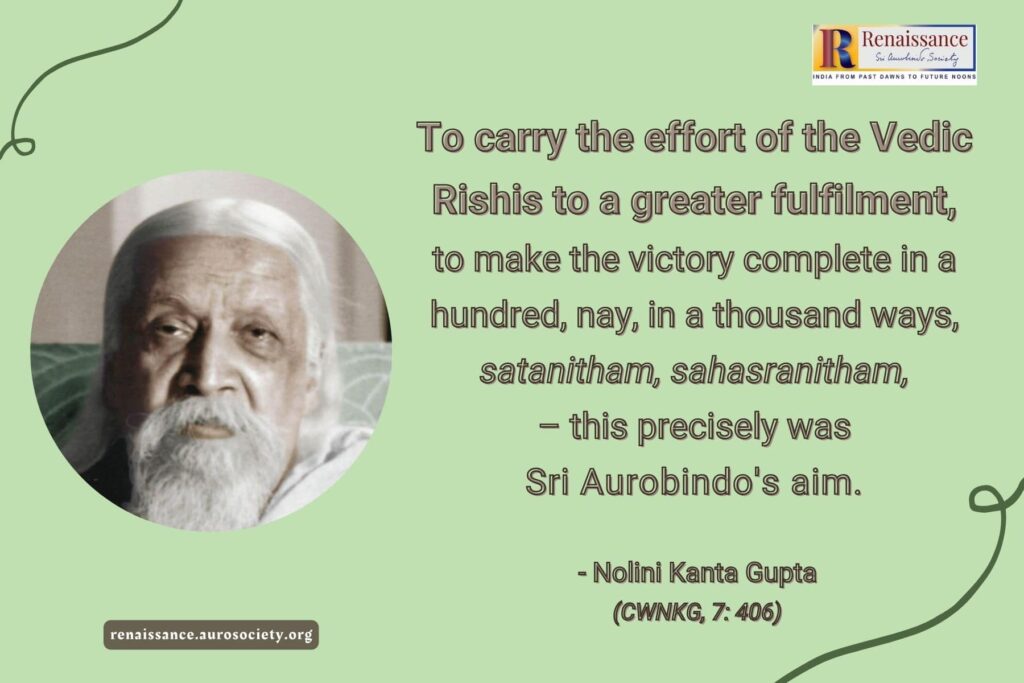
Sri Aurobindo’s Unbudging Determination
At one time, they made up their minds that Sri Aurobindo should be kidnapped in a car with the help of one of the chiefs of the local “bandes”. We had to patrol all night the house in which Sri Aurobindo lived, lest there should be a sudden attack. I gather the ringleader behind this move showed repentance later and said that to act against a holy man and yogi was a great sin and that a curse might fall on the evil-doer himself.
Nevertheless, force having failed they now tried fraud. An attempt was made to frame a trumped-up charge at law. Some of the local “ghouls” were made to help forge the documents – some photographs, maps and charts along with a few letters. These were to prove that we had been engaged in a conspiracy for dacoity and murder. The papers were left in a well in the compound of one of our men. Then they were “discovered” after a search by the police.
The French police had even entered Sri Aurobindo’s residence for a search. But when their Chief found there were Latin and Greek books lying about on his desk, he was so taken aback that he could only blurt out, “Il sait du latin, it sait du grec” – “He knows Latin, he knows Greek!” – and then he left with all his men. How could a man who knew Latin and Greek ever commit any mischief?
[…]
In addition to force and fraud, the British Government did not hesitate to make use of temptation as well. They sent word to Sri Aurobindo which they followed up by messenger, to say that if he were to return to British India, they would not mind. They would indeed be happy to provide him with a nice bungalow in the quiet surroundings of a hill station, Darjeeling. He could live there in complete freedom and devote himself to his spiritual practices without let or hindrance. Needless to add, this was an ointment spread out to catch a fly and Sri Aurobindo refused the invitation with a “No, thank you.”
Afterwards came a more serious attack, perhaps the one most fraught with danger.
The First World War was on. India had been seething with discontent and things were not going too well abroad on the European front. The British Government now brought pressure on the French: they must do something drastic about their political refugees. Either they should hand them over to the British, or else let them be deported out of India.
The French Government accordingly proposed that they would find room for us in Algeria. There we could live in peace. They would see to our passage so that we need have no worry on that score. If on the other hand we were to refuse this offer, there might be danger: the British authorities might be allowed to seize us forcibly.
I can recall very well that scene. Sri Aurobindo was seated in his room in what was later called “Guest House”, Rue Francois Martin. We too had come. Two or three of the Tamil nationalist leaders who had sought refuge in Pondicherry came in and told Sri Aurobindo about the Algeria offer and also gave a hint that they were agreeable.
Sri Aurobindo paused a little and then he said in a quiet clear tone, “I do not budge from here.”
To them this came as a bolt from the blue. They had never expected anything like this. In Algeria there would be freedom and peace, whereas here we lived in constant danger and uncertainty. But now they were helpless. Sri Aurobindo had spoken. And they could hardly act otherwise. They had no alternative but to accept the decision, though with a heavy heart.
[…]
The Ashram has of course been subjected to fresh attacks later. . . But by then the Ashram had its foundations well laid and the edifice had risen high. But in the days of which I have been speaking there was no such thing as a foundation yet.
Read a Travelogue in Hindi by Charan Singh Kedarkhandi:
Pondicherry Yatra, an Inner Journey
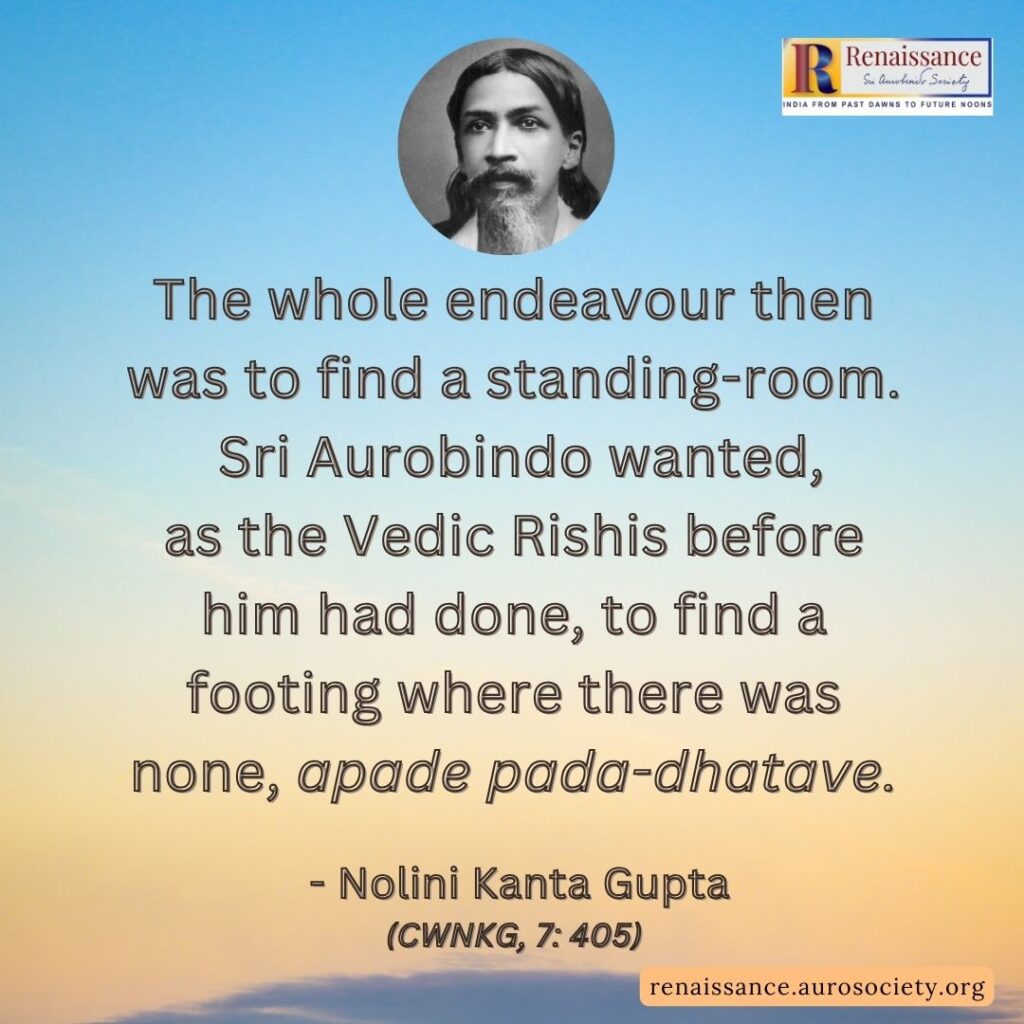
Ashram – The Location of Ancient Vedapuri
Today the Ashram stands like a banyan tree with head erect and branches spread all over.
Its body is solid and immovable. The roots go deep and strong and firm. An attack may dislodge or even break a few leaves and branches, but, nothing more serious can happen. But in those days there was a possibility that the whole tree might get uprooted. And such attempts too were there.
The whole endeavour then was to find a standing-room. Sri Aurobindo wanted, as the Vedic Rishis before him had done, to find a footing where there was none, apade pada-dhatave.
In those days there was in the College de France in Pondicherry a French professor named Jouveau Dubreuill. Later on he became quite a well-known name – who had been engaged in research in ancient history and archaeology. We knew him quite well. He was at that time working on the early history of Pondicherry.
From a study of the ancient documents and inscriptions he discovered that the city of Pondicherry, which I have called a city of the dead, had at one time been known as a city of the Veda, veda-puri. That is to say, it had a centre of Vedic learning. And this Vedic college, our professor found from ancient maps and other clues, was located exactly on the spot where the main building of our Ashram now stands.
According to ancient tradition, Rishi Agastya came to the South to spread the Vedic lore and the Aryan discipline.
. . . The legend goes that as Agastya journeyed South, the Vindhya mountains bent low to give him passage. And that they have remained low ever since and would continue in that posture until the Rishi came back. In connection with this story about the Vedic Rishi Agastya, one is almost automatically reminded of the endeavour of Sri Aurobindo.
Like Agastya, he journeyed South and set up a permanent seat here to emanate a new Light. He was even known in these parts as Uttara Yogi, the Yogi of the North.
In his lines of work and sadhana too we find a strange affinity with Agastya’s effort, at least in one respect. Agastya had been for years driving deep into the earth, in the abyss of the subconscient, for he nourished both the worlds, earth and heaven. He along with his companion Lopamudra had been striving for victory here upon earth itself. In their battle and the sacrifice with its hundred fiery tongues, jayavedatra satanithamajim, yat samyañca mithunababhyajava; for the effort that had the protection of the gods could never, fail, na mrsa srantam yadavanti devah.
To carry the effort of the Vedic Rishis to a greater fulfilment, to make the victory complete in a hundred, nay, in a thousand ways, satanitham, sahasranitham, –this precisely was Sri Aurobindo’s aim.
Sri Aurobindo was in Pondicherry for forty years. The first few years were spent in establishing a seat. He had to select a suitable spot and make a permanent abode where he could work undisturbed. This point about selecting a “seat” occurs in the story of all great spiritual aspirants and in all the disciplines.
The Tantriks had need of their “seat of five skulls”, pañcamundi. Ramakrishna had his pañcavati, the grove of five sacred trees. But why this insistence on five? Perhaps the number stood for the five main elements in man and the five worlds that constitute the universe, – what the Upanishads term body, life, mind, supermind and spirit.
The Vedas too speak of pañcaksiti, the five abodes, pañcakrsti, the five fields of culture, pañcajana, the five births or worlds. Sri Krishna’s conch of pañcajanya may well occur to the mind. Lord Buddha too when he took his seat under the Bodhi tree is supposed to have said, “I do not rise from this seat until my aim is attained, even though the body dry up or fall” (ihasane suyatu me sariram).
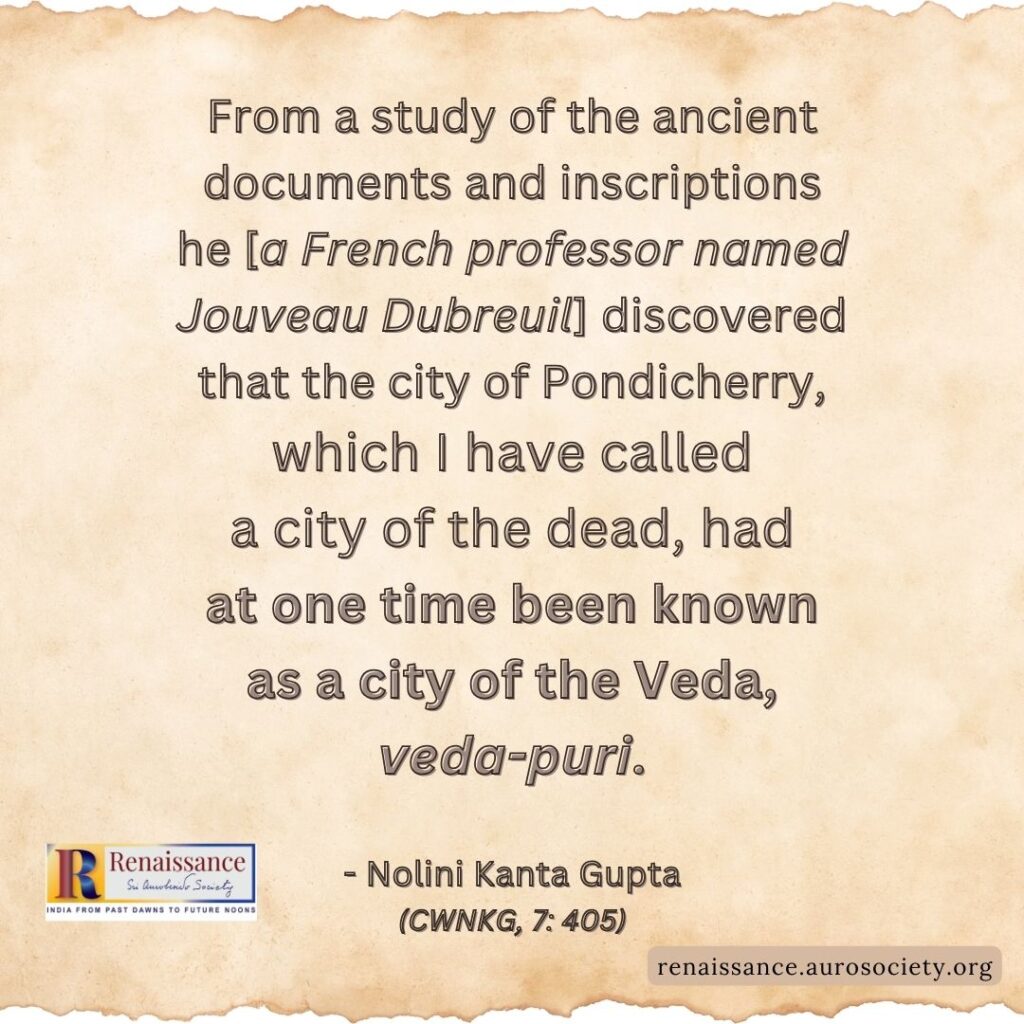
Ashram – The Divine Mother in Earthly Form
The site once chosen and the seat established, Sri Aurobindo had now to prepare the ground. There were, as I have said, shifting sands all around symbolising a changing world where all is in a state of flux, yat kiñca jagatyam jagat. All that had to be cleared and firm ground reached. He spent many long years, even as Agastya had done, in this spade-work. For he was to erect a huge edifice, a Temple dedicated to God.
He had once dreamed of a Temple for Bhawani, Bhawani Mandir, where he would install Mother India. Now too he desired the same thing, a Temple for Bhawani, a Temple-city in fact.
That needed a solid, firm and immovable foundation. For this he had to dig into the farthest abyss, to fix, one might say, the “five supporting pillars”. All this he did single-handed during the first four years, from 1910 to 1914. Then the Mother came. And although that was for a short time, it was then that the plans were clearly laid for the thing that was to be and the shape it was to take, – this New Creation of theirs.
The work of building the foundation took him till 1920.
From 1920 to 1926 he worked with the Mother in giving it strength, testing it and making it fit and adequate for carrying the future load. In 1926 there began the construction of the superstructure, and along with that proceeded the work of installing the presiding Deity. This work of installation took twelve years to complete and the next twelve were given to making it permanent.
His task done, Sri Aurobindo stepped aside, for a new task, for taking up another line of work. But to this foundation he lent the entire strength of his bare back, that his work and new creation should stand immortal and with its head erect.
All that Sri Aurobindo had wanted to do with his body was to install permanently in an earthly form the Mother Divine.
This Temple we call the Ashram has grown through the Power and Influence of Her physical Presence, in order that She may manifest anew.The Divine Mother of the worlds has installed Herself here. In the golden Temple the living Goddess is manifest with all Her Powers of realisation. She has Herself taken charge of the Work now. And the power of Her Grace is working towards the goal that the entire earth and the race of men grow into a living manifestation of Herself.
Notes
* We might say of course from another point of view that it was Sri Aurobindo who gave shelter to Pondicherry within his own consciousness. But why this city in particular? There is indeed the usual view that he retired into French territory to escape the wrath of the British bureaucracy. But actually, all he wanted was to find a quiet spot where he might give himself to his own work undisturbed.
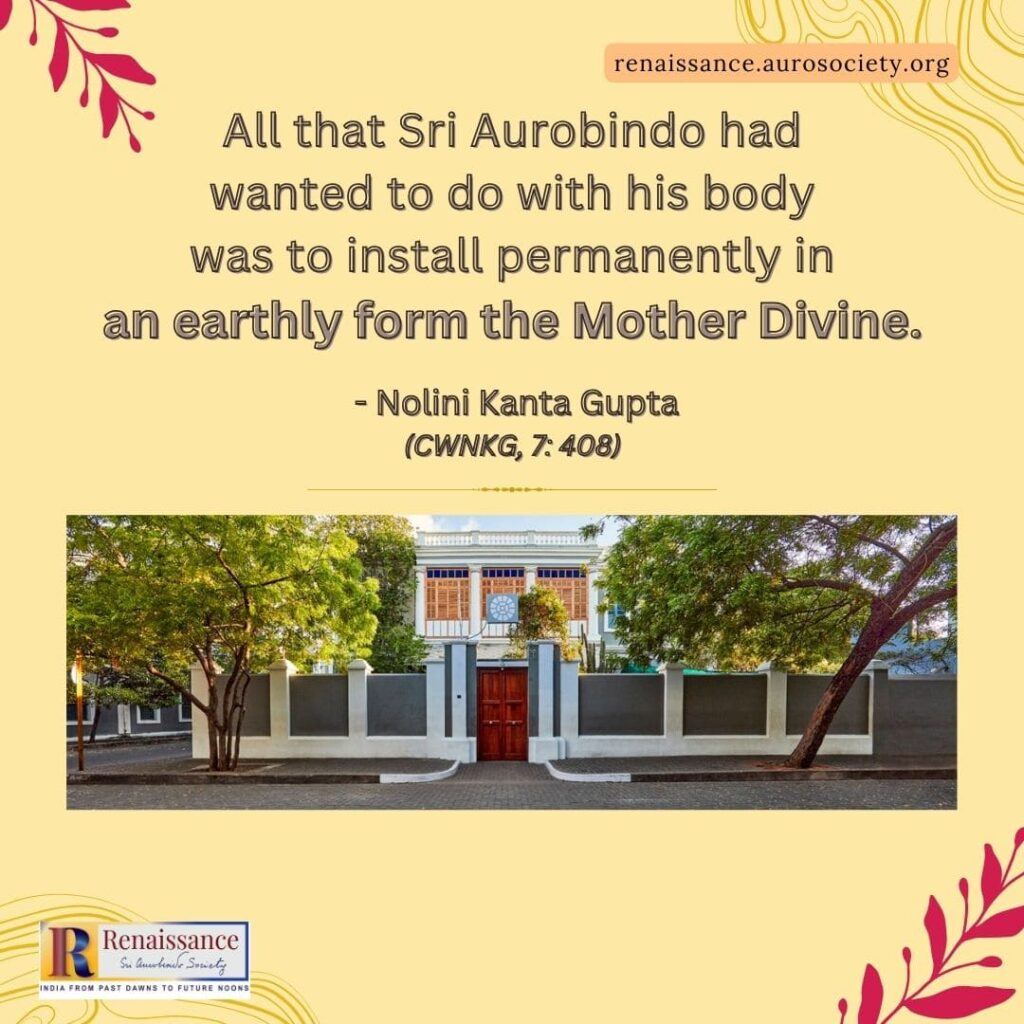
Also Read From The Mother:
Of Supermind, Vedic Rishis and Sri Aurobindo
🌸🌸🌸
~ Design: Raamkumar

